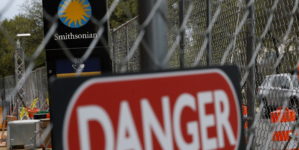-
Adams Praises Kash Patel’s Book, Doubling Down on Trump Alliance - 7 mins ago
-
Not Content With His Present Power, Trump Tries to Control the Past, Too | Opinion - 20 mins ago
-
Elon Musk Backlash Turns Into Global Sales Slump for Tesla - 52 mins ago
-
How to Watch Liverpool vs Everton: Live Stream Premier League, TV Channel - 55 mins ago
-
Meet Sunny and Gizmo, Big Bear’s newest bald eagle residents - 59 mins ago
-
DC’s ‘Lanterns’ Casts ‘The Walking Dead’ Star For Mysterious Role - about 1 hour ago
-
Eric Adams’s Charges Were Dropped, but His Re-Election Chances Remain Dim - 2 hours ago
-
CBS’ Complete Masters Coverage Revealed with a New Wrinkle Fans Will Love - 2 hours ago
-
Supreme Court Rules Against Makers of Flavored Vapes Popular With Teens - 2 hours ago
-
After botched fire evacuations, L.A. County considers disaster registry for elderly, disabled - 2 hours ago
Cutting Off NPR and PBS
There is no reason, Republicans say, for the government to fund NPR and PBS.
Last week, G.O.P. members of Congress, led by Marjorie Taylor Greene, flayed the leaders of both organizations for what they said was partisan programming. “You all can hate us on your own dime,” Greene said. The next day, a Republican introduced a bill to end all government support.
What would happen to public broadcasting if Republicans succeeded? In today’s newsletter, I’ll explain.
NPR
The specter of government abandonment has haunted public radio for so long that executives drafted a secret plan for the worst.
In February 2011, NPR assembled a 36-page document that detailed exactly what would happen if the Treasury stopped cutting checks to the Corporation for Public Broadcasting, the government-backed company that supports NPR and PBS. The document, which has not previously been reported, is bleak. It describes a precarious radio system that will bear the blow poorly, with consequences for listeners across the nation.
“Most NPR member stations operate at, or barely above, break-even,” it begins. A cutoff would cause up to $240 million to vanish and up to 18 percent of roughly 1,000 member stations to close. The Midwest, the South and the West would be affected the most. Nationwide, up to 30 percent of listeners would lose access to NPR programming.
NPR provides national coverage, but the independent member stations across the country get most of the money devoted to public radio. That makes them more vulnerable than the national headquarters, which says it gets only 1 percent of its budget from Congress. (It gets a bit more from local stations that pay for its programming).
What are these local stations doing? Take WEKU, a constellation of 10 FM stations with headquarters in Richmond, Ky., that broadcast to nearly 1.5 million residents. For people who don’t have access to broadband internet, WEKU is one of the few reliable sources of information when emergencies happen.
Floods swept through the state earlier this year. “Our transmitters stayed on the air, and we were broadcasting information to residents in Pikeville on where they could get fresh water, how they could deal with FEMA,” said Mike Savage, the station’s director and general manager. NPR’s audience has fallen by about 28 percent since 2020. But many of the residents who still tune in really need the information.
After the floods, someone from Hazard, Ky., emailed Savage to say that public radio was her only source of vital information. “We were her lifeline because they had no power, they had no cell service, they had nothing except for listening to our public radio station and getting information every day,” Savage said.
NPR can weather the funding cut, its document predicts, thanks in part to aggrieved listeners: Executives predict a sudden boom in donations if Congress defunds it, as listeners rush to defend their favorite programs. But they will likely give more in big-city markets.
PBS
Public television in the United States would likely be in worse shape because PBS receives much more of its budget — about 15 percent of $373 million — from the federal government.
There’s something quirky about PBS: Many of the shows operate their own businesses. So marquee programs like “PBS NewsHour” and “Nature” would need to find money elsewhere, such as from donations or syndication.
But again, the member stations, which rely more on public funding than the national organization does, would bear the brunt. Those stations use the money to cover local affairs, often in a news desert. Alaska Public Media, for instance, is a PBS and NPR member station with several local affiliates in rural areas. Those team up with newspapers, including The Daily News-Miner in Fairbanks and The Juneau Empire, to cover state and local governments.
That’s crucial, in part, because reliable sources of information are disappearing from smaller towns across America, said Paula Kerger, the chief executive of PBS. “There isn’t an economic model that would compel commercial broadcasters to have outlets strewn across the state where the population is so sparse,” she said.
Public and broadcasting
It’s not an issue that moves large voting majorities. About a quarter of American adults believe that public media should be defunded, and 43 disagree, according to the Pew Research Center.
In the past, members of Congress have been persuadable. In 1969, as Congress contemplated reducing funding for public media, members invited Fred Rogers, the creator of “Mister Rogers’ Neighborhood,” to testify. Lawmakers sat rapt as he quoted a song he’d written about keeping anger under control.
One legislator said that Mister Rogers had given him “goose bumps” and acknowledged that the testimony had saved the day. “Looks like you just earned the $20 million.”
A half-century later, the party that controls Congress is tuning those arguments out. When Mister Rogers’s testimony came up at the hearing last week, one witness said that Congress shouldn’t have listened to him.
THE LATEST NEWS
Trump Tariffs
-
President Trump is set to reveal the details of his global tariff plan tomorrow, a date he has called “Liberation Day.” Advisers have debated whether the plan should raise tariffs or lower them.
-
At the core of Trump’s tariff plan is a risky bet: that Americans will accept higher prices if it helps bring back manufacturing.
-
The administration released a list of foreign trade barriers that could influence the planned tariffs.
-
Uncertainty over tariffs caused S&P 500 index’s worst month in more than two years.
-
The Fed is speaking with companies to figure out to what extent Trump’s policies will create inflation.
Government Overhaul
Immigration
More on Politics
Mess hall menus: Can the Army make food that soldiers will actually enjoy? A TV chef wants to help.
Fossils: It was a hole in the ground behind a New Jersey home improvement store. Now it’s a state-of-the-art dinosaur museum.
Most clicked yesterday: For the second day in a row, the most clicked link was the story of a scandalous hot yoga class.
Lives Lived: Hank Steinbrecher was a top official in U.S. soccer who helped usher the sport into the American mainstream. He died at 77.
SPORTS
Women’s college basketball: The women’s Final Four is set after victories for UConn, led by Paige Bueckers, and Texas.
M.L.B.: The Braves outfielder Jurickson Profar will miss the next 80 games after testing positive for a fertility drug often taken after steroids.
ARTS AND IDEAS
Since “Othello” was first performed in the 17th century, one question has plagued audiences: Who owns the production, Othello or Iago? “Othello” is the only major Shakespeare work that gives the hero and the antihero equal weight, which means the contest between the actors playing them has always been fierce. As one scholar put it: It is Othello’s tragedy, but Iago’s play. Read about famous stagings.

















